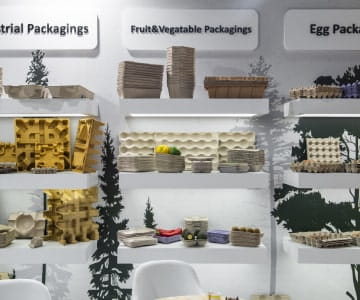Plastic remains the unrivalled heavyweight of packaging
With 3500 specialised companies in France accounting for an aggregate turnover of more than €32 billion, plastic still enjoys unparalleled success in the field of packaging, even if its production has dropped by 11% in 2020.
Its main strength is its versatility, which makes it easy to use for all the user industries to which the packaging sector caters, including in terms of secondary or tertiary packaging (boxes, films, bags, etc.). It has the advantage of being watertight and able to contain liquids without damage or deterioration; and it is easy to handle while also being light and resistant.
For the French packaging industry, plastic is still extremely prevalent, since it represents almost 29% of the sector's entire turnover. Also, one job in three in the sector is directly linked to plastic, not to mention the indirect jobs generated by the material. Lastly, the fact that France is the world’s fifth largest exporter of packaging can be largely attributed to plastic, which accounts for more than €2 billion in turnover abroad (or an export rate of almost 30%).
Medium-term threat due to its major environmental impact
The issues affecting the industry today and tomorrow are centred on the environmental questions: with an increasing role in the choices consumers make, and the involvement of governments in searching for drastic reductions to the global ecological footprint, sustainability is a decisive factor for the materials used by the manufacturing industry. In this regard, plastic has fallen out of favour.
Its image suffers from its association with single-use packaging and overwrapping; from a production process synonymous with pollution and costly in fossil fuel (plastic being derived from oil); and a recycling rate that is still very low (26% of plastic packaging recycled in 2018, according to a survey of 60 million consumers). Legislation, moreover, stipulates the elimination of single-use plastic packaging by 2040, while disposable plastic bags are already banned from use in stores.
ALL4PACK EMBALLAGE PARIS at the cutting-edge of innovation for reinventing plastic
The new challenges facing the plastic packaging sector are therefore forcing it to reinvent itself, to be able to retain its position as leader.
ALL4PACK EMBALLAGE PARIS offers you the ideal meeting and demonstration platform to convince your customers and prospects of the quality of your solutions:
- Contact and meet up with your prospects and customers with ease, thanks to our matchmaking app
- Increase your visibility by being identified as one of the plastic solutions suppliers in our paper and online catalogue, with its indexation by material, and in the visitor pathway devoted to plastic
- Communicate your presence ahead of the event thanks to customised banners generated by our mediakit
- Declare your novelties and the products that you will be presenting at the show in our list of products, and enter your innovations for ALL4PACK Innovations.
Come and meet the professionals from the user industries of plastic packaging (CEO, project managers, R&D directors, etc.) in 2024.
Source: Emballage magazine No. 1012 Statista 2018




